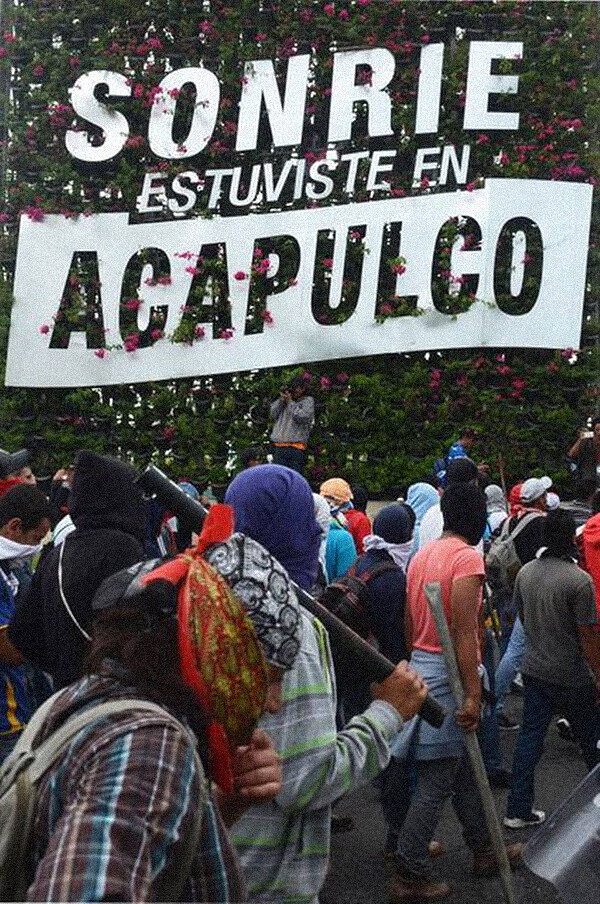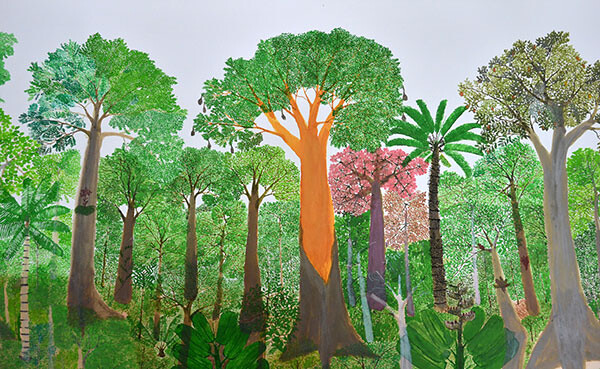You speak of a world that is yet to come. Most of us are not ready to sacrifice the happiness we can access here and now, however artificial, shallow, or environmentally dangerous it may be, so I keep doubting your politics in secret. How on Earth will you convince the world to live your vision?
—Maja Borg, from the voiceover of her film The Future My Love (2014)We have to acknowledge that the significant political leverage required to simultaneously block the economic exploitation of our people and homelands while constructing alternatives to capitalism will not be generated through our direct actions and resurgent economies alone. Settler colonization has rendered our populations too small to affect this magnitude of change. This reality demands that we continue to remain open to, if not actively seek out and establish, relations of solidarity and networks of trade and mutual aid with national and transnational communities and organizations that are also struggling against the imposed effects of globalized capital.
—Glen Sean Coulthard, Red Skins, White Masks
I want to begin with a fictional scenario that crystallizes the perils and possibilities of our present moment:
Last night, the Acapulco Diamante tourism complex in Mexico—with over 150,000 rooms in its multiple apartment buildings, luxury housing complexes, and international hotels spread across five kilometers between the Mayan Palace and the Princess Hotel—was peacefully taken over by ten thousand displaced families from various zones in Guerrero (mostly from Tierra Caliente), escorted by two thousand vigilantes from the mountains of Guerrero and commandos from the armed wing of the ERPI (Revolutionary Army of the Insurgent People). The uninvited intruders are environmental refugees, as their homes and lands have been destroyed by extreme weather and megaprojects such as mineral extraction and hydroelectric dams. Some have been displaced to cheap suburban-like housing areas, where they have been made dependent on government aid, debt, and corporate forms of subsistence. This has made them estranged them from their lands and autonomous means of subsistence. By peacefully taking over the Acapulco Diamante tourism complex, they seek to fulfill their human right to “modern” commodities and infrastructure, which they will use to reinvent their communal forms of living. What remains to be seen is how they will gain access to health care, education, and jobs.
The takeover, executed in collaboration with the tourism complex’s employees—waiters, security guards, maids, and gardeners, who politely escorted shaken tourists to the bus station and airport—takes place after years of planning by a team of international environmentalists, leftist guerrilla strategists, Palestinian architectural decolonists, radical cultural producers, biologists, environmentalists, an international team of anthropologists from indigenous communities, and community leaders representing one hundred of the nearly four hundred ethnicities still surviving across Mexico. The interdisciplinary team has taken up the task of organizing communal forms of living in the complex, following the desires, needs, and concerns of the natives of the mountains in Guerrero. Their goal is to reconvert the Acapulco Diamante tourism complex into a sustainable habitat by restoring the ecology of the area; one of the first tasks is to turn the pools at the luxury hotels into fish farms. Technology and know-how have been imported from Gaza to build a desalinization and water-treatment plant, and from Belgium to build a solar energy system. Also underway in the fabrication of simple biodigestors designed by a Mexican artist to produce methane gas. A Norwegian NGO is providing financial aid to help feed the community until they are able to grow and harvest their own food, but they are also accepting donations. A group of concerned cultural producers from Mexico City has arrived to show solidarity and collaborate with the community, eschewing the model of “intervention.” They have been asked to help transform the hectares of golf courses into arable land where papaya, banana, maize, quinoa, and wheat will be grown. A team of French-Algerian anthropologists who grew up in the Parisian banlieues has come to help the community settle.
The community is debating many pressing issues, including how to use the tourist architecture and infrastructure to organize communal forms of living. Also up for discussion is whether one building will be saved to house three hundred Syrian refugee families. In the next few days, refugees from Hurricane Patricia will be arriving by boat from Jalisco, Guerrero, and Nayarit. Peace talks are taking place with federal authorities, who have threatened to cut off energy and water, or even to invade the complex and violently expel the new inhabitants. The owners of the Acapulco Diamante tourism complex have been asked for comment, but so far they have remained silent.


Syrian refugees Hala and Zeina play on a disused water slide inside LM Village Resort, closed as a result of Greece’s financial crisis. Photo: UNHCR/Achilleas Zavallis
The global dominance of neoliberal policies has precipitated the collapse of democracy and the resurgence of neofascist ideologies worldwide. In the midst of economic instability, the ranks of redundant, excluded populations continue to swell, global warming intensifies, and new forms of slavery emerge. Meanwhile, a model of development based on foreign investment and phantasmagoric economic growth continues to be imposed by international institutions, resulting in endemic state violence (Ayotzinapa, Palestine), permanent war (Iraq, Syria), pervasive environmental devastation, and the destruction of communities and their forms of life. If neoliberalism describes the dominant political economic understanding, then this understanding is unquestionably a threat to our existence.
Were this text being written in the previous century, the part of neoliberalism would likely have been played by “imperialism,” and it is significant that David Harvey has written extensively on both concepts. In his book The New Imperialism, Harvey expands Marx’s concept of “primitive accumulation” to encompass intellectual property rights, privatization, and the depredation and exploitation of the commons. In these new processes of primitive accumulation life itself is put on the line, in what Harvey calls “accumulation by dispossession.” The commons become the cheap “resources” feeding the concentrated accumulation of wealth that is destabilizing the economy. The questions to be asked today, after Bifo, are: How to recompose social autonomy? How to protect life against financial capitalism and national and religious fascism? How to supplant neoliberal policies? What social model is capable of replacing the dictatorship of the market?1
It is important to understand how neoliberalism’s basic rhetoric of market democracy conceals vast inequalities of access. It is simply not the case that individuals confront equal choices when it comes to goods, services, education, jobs, and housing, choices which allow them to allocate resources according to inclination. This is the paradoxical element in the effort of some contemporary political movements to “improve” democracy by demanding transparency, accountability, inclusion, and freedom of expression. How can we speak of democracy if entire populations across the world have differential access—or a complete lack of access—to its preconditions, to good, resources, and services? Under the chimera of freedom of choice provided by the liberalization of the market, consumers have the apparent option to choose from a wide range of qualities and prices. In reality the “choices” available to large segments of the population are not choices at all.
A Mexican example of differential access is health care services, which vary widely in quality and cost according to the economic situation of the patient. There is Doctor Simi, a franchise that offers medical consultations and prescription medicine for under five US dollars; in contrast, the English Hospital (ABC) in the privileged area of Santa Fe charges as much as one hundred and seventy US dollars for the same service, sometimes more. The democratic assumption of individual equality before the law is thus limited in advance, specifically to whatever equality is available in a community where the health of one small group is worth thirty-five times that of another, much larger group. As in organic versus industrialized food, the disparity in health care services leads to other, greater disparities. How can one “be political” in the way that neoliberal success demands if one suffers from chronic heart disease brought on by eating industrialized food? There can be no rule of law if one cannot appear in court on account of one’s ill-health. Neoliberalism functions by providing differential access to the preconditions of citizenship such as health care, housing, and education.
Another example of differential access is preferential lines at banks, which allow clients with important accounts to have faster access to tellers. Those who can afford it are able to avoid long lines. At the global level, there is the Global Entry Pass, a membership service that offers speedy entrance to the US in exchange for personal information and a fee (on top of the normal visa fee). These forms of differential access to goods, borders, and infrastructure institute inequality beyond the apparent reach of any national democracy, normalizing it and making it systemic. Perhaps the clearest example of the global system of differential privileges was revealed by the Panama Papers: tax havens that launder the riches of the global elite. These allow wealthy individuals to become ruling-class thieves, enjoying the safety and security provided by tax-collecting governments without paying for them.


Still from the 2015 movie This Changes Everything by Avi Lewis based on the book with the same name by Naomi Klein.
This logic of differential access and privilege is written into the form of neoliberal imperialism: the state makes itself strategically present, protecting and providing for certain territories and populations while neglecting or repressing others according to the interests of global capital.2 This is evident, for instance, in the way in which Israel co-governs Palestinians as noncitizens, that is to say, as citizens with different rights than Israelis.3 Globally, these forms of differential access/governance have become entrenched with the emergence of oligarchies who have amassed enormous fortunes through privatization, resource extraction, real-estate projects, and other forms of monopoly investment at a global level. Emboldened by the free movement of capital, these cliques threaten nation-states with disinvestment unless they agree to depress the cost of labor by making war on their middle-class institutions like unions and schools. The architecture of upward mobility is, by definition, tasked with raising the price of labor-power, and when nation-states compete internationally for investments, this cost must be driven downwards. Hence the definitively neoliberal spectacle of nation-states gleefully ransacking their own national institutions in the name of the nation. Entire governments now play the role of strike-breakers and factory guards. Traditionally, democracy was based on the social force of workers, and electoral democracy was its manifestation. The mechanism of national democracy was how workers defended the price of their labor. Since the triumph of the neoliberal program, however, national democracy has shown itself incapable of maintaining the wage rate in particular, and standards of living more generally, and this accounts for the sudden affection for a different kind of nationalism in Europe, the US, and Latin America, and the shift towards populist, anti-refugee, and authoritarian positions.4 As Bifo has argued, the fading possibility of emancipation and organization has pushed workers towards the only forms of identity that remain available: ethnic, religious, and national belonging.5 Right-wing politics has provided token identification on a cultural or spiritual level, offering a symbolic unity that replaces the eroded welfare state and failing democracies. Instead of the redistribution of wealth we have a nationalist closing of borders, as people participate symbolically in the ideological projects of oligarchies but without participating in them financially.6 If national democracy is a mutilated tool devoid of efficacy and credibility, what paradigm of resistance might appeal to precarious and excluded populations, peoples whose lives and livelihoods are being rendered precarious or destroyed?
As solutions to our current global problems, Žižek proposes a new workers’ movement, while Bifo has suggested inventing forms of recombinant autonomy and a new internationalist Left. Yet contemporary ecological mutations require that we ask whether or not the principle of representation at the heart of our inherited models of struggle has become obsolete. In other words, it is not only the crypto-government of transnational capital that has superseded the form of the nation-state; such states are also undermined by territorial conflicts created by irreversible ecological events. Is it absurd to seek new forms of representativity for those agents involved in climate change like “soils,” “the atmosphere,” “oceans,” and “cities”? Bruno Latour thinks so. But it is equally senseless to pursue a collective figure of exclusively human being that could function as a new agent of geohistory, like the proletariat once did.7
Nick Srnicek and Alex Williams have demanded that the Left make use of the latest technological developments to liberate humanity from work while simultaneously producing wealth.8 However, it is not clear how this new dream of a postwork society of full automation escapes the early twentieth-century fantasy of technology and knowledge as spontaneously emancipating—a dream that sits uncomfortably alongside the neoliberal deployment of technology as a tool of domination. How is this not simply another example of Herbert Marcuse’s use and abuse of “technological rationality”? Certainly technology will always relieve some people of work and produce wealth—that has never been the difficulty. The difficulty lies in taking a world shattered by technology and socially reconstructing it as a just, peaceful, and sustainable ecosystem, a project that is beyond the means of technology, in and of itself.
A skeptic of technological advances and their effects on society, US philosopher Alvin Toffler coined the term “future shock” in 1965 to designate the disastrous tension and disorientation provoked in individuals when they are confronted with excessive change in a brief span of time. The shock is caused not only by technological advances, but also by the increasing speed of population growth and urbanization, bringing about a historical crisis of adaptation.9 Along opposite lines, Jean-François Lyotard observed that the destruction brought about by modernization was in fact a source of jouissance for the peasants who became unemployed proletarians:
They enjoyed the mad destruction of their organic body which was indeed imposed upon them, they enjoyed the decomposition of their personal identity, the identity that the peasant tradition had constructed for them, enjoyed the dissolutions of their families and villages, and enjoyed the new monstrous anonymity of the suburbs and the pubs in morning and evening.10
For Lyotard, in the imposed destruction of their bodies, lives, and traditional ways of making a living, the peasants experienced jouissance in the form of masochistic pleasure. This destruction was perceived as the necessary sublation of the many antagonisms inherent to modernization and the development of a superior mode of production. In contrast, Toffler thought that the shock brought about by technological change and modern acceleration needed to be prevented by implementing a policy that embraced technological innovation while also taking into account the secondary long-term effects of technology, specifically, the effects of technological development on the environment.11 For Toffler, future shock was also caused by the failure to calculate the long-term impacts of technological innovation on society and culture.
In spite of the human and environmental cost, industrialism and technocracy as technological rationality are still perceived as emancipatory tools as well as systems geared toward maximizing the material well-being of humans. This is why, in spite of multiple UN Climate Change Conferences and efforts to make capitalism more “green,” the stability of the environment is under ongoing threat. In reality, there can be no such thing as green capitalism because capitalism is built precisely on the logic of technological rationality, which implies the negation of the environment itself.


Masked students block access to the Acapulco airport, where a sign reads in Spanish “Smile you were in Acapulco,” as they protest the disappearance of 43 students in the state of Guerrero, Mexico, Monday, Nov. 10, 2014. Photo: AP Photo/Bernardino Hernandez.
Technological rationality, insofar as it is the rationalization of the domination of nature and society, is the foundation of our current model of accumulation by dispossession, exploitation, and extraction. This model has not only created environmental and social destruction; it has also divided the world into privileged urban areas and what Naomi Klein calls “sacrifice zones.”12 These sacrifice zones are the contemporary manifestation of the colonial model; once the imposed project of development failed to modernize “primitive” societies, their lands were transformed into zones of pure extraction. Residents of these sacrifice zones not only live with the toxic waste of our systemic need to consume fossil fuels (undergoing, as Rob Nixon calls it, a form of “slow violence”13) and face the destruction of their autonomous forms of sustainability in the name of development; they also sustain the privileges of people living in developed urban areas, people who deny or justify this destruction under the logic of modernization. Megaprojects are a clear manifestation of this. Dams, oil and natural gas pipelines, shopping malls, real-estate developments, and infrastructure projects such as the Eurotunnel or the Boston Big Dig constitute the infrastructure of global capitalism; they are the spatial manifestation of neoliberal capitalist development on a global scale. The purpose of megaprojects is to integrate spaces existing under older forms of production into the dominant accumulation model. They are therefore destructive and directly linked to technological rationality insofar as they posit nature as a resource and “pure” background against which social and economic life can be developed.
Another characteristic of megaprojects is that social movements tend to organize against them; examples in Mexico include Atenco, La Parota, Temacapulín, Acasico y Palmarejo, and Río Verde in Oaxaca. Filmmaker Dan Cameron has documented the decades-long struggle against the construction of the Belo Monte Dam in Brazil. In India, the Dongria Kondh people are struggling to protect their native land from bauxite mining by the British company Vedanta (Arundathi Roy has written extensively about this struggle). Megaprojects are a combination of neocolonialism and modern technocracy’s refusal to take into account the long-term effects of connecting peripheral zones to the global circuits of economic exchange.
There is an ongoing debate about what to call our current era, which began more or less with industrialization and the invention of the steam engine, creating visible and irreversible human impacts on Earth. The terms “Anthropocene,” “Capitalocene,” and “Chthulucene” have been coined not only to describe the origin of the phenomena we are undergoing, but to politicize them, seeking to take into account the extractivist and destructive logic behind technological rationality’s drive to dominate nature and society.14
Arguably, the source of the ideology of technological rationality can be found in the Western division between nature and culture. From a feminist perspective, Donna Haraway explains this as an epistemological problem. In her view, the separation between nature and culture underlies modes of knowledge such as scientific compartmentalization, the naming of things, and the reincorporation of natural knowledge as means of control.15 Along similar lines, for Habermas (who expanded upon Marcuse’s notion of technological rationality in a 1971 text), subjecting nature to language and symbols creates a division between cognizant subject and object, establishing a relationship of foreignness between them.16 When we classify, name, and create types, culture becomes the logic through which we access nature, which is perceived as a priori dangerous and instinctual.
Bearing this in mind, the environmental devastation we are currently witnessing not only compels us to take concrete steps to stop deforestation, mineral extraction, the burning of fossil fuels, etc. We must also acknowledge the colonial basis of modernity and modernism. The logic of technological progress as emancipation is inherent to colonial narratives. At its core, colonization implies a process of destruction for the sake of creating a purified, homogenous present that defines itself against a past of barbarism and Otherness—all in the name of progress.17 Along with modern science and culture, critique is also a tool that purports to facilitate progress while really just underscoring the givens of imperialism. Modernity relies on critique to reinvent itself and to justify colonial exploitation, creating new hybrids and paradoxes and finding new ways to look at the world and our relationship to the past.18 Critical theory (from Marx and the Frankfurt School to post-structuralism and postworkerism, including their more recent derivations) assumes that modernity provides the social, economic, and cognitive means of human emancipation. In this way, it perpetuates a series of oppositions: nature vs. culture; development vs. underdevelopment; degrowth vs. acceleration; indigenous struggles to protect the environment vs. extractive capitalism.
The modern point of view imagines the future as one of renewable energy and social and biological engineering; design will make life sustainable, and science and technology will produce abundance and progress. And yet, as Seth Denizen suggests, the Anthropocene marks the moment when the confidence that there can be a technological solution for our problems as a species is now over.19 At the same time, our responsibilities as privileged and educated inhabitants of the “developed” areas of planet are not clear; nor is the relationship between our everyday lives and the environmental destruction they enable on the other side of the planet. In other words, one reason why it is difficult to politicize the processes and logics driving ecological disaster is that we are deeply immersed in them. Inequality and differential access have been normalized not only by the concept of market freedom, but also by the history of European colonization. Sacrifice zones are the continuation of colonial processes that began five hundred years ago.
This assault on non-market forms of collectivity also explains why political struggles over similar issues in different parts of the world remain disconnected, often withdrawing into localized environmental battles or transforming into identitarian campaigns. In the latest wave of primitive accumulation, shale gas extraction has polluted the drinking water of many families in rural parts of North America, such as Colorado and Quebec. In some cases, residents’ tap water has become flammable, and so they have resorted to buying bottled water from private companies. Like many others around the world facing similar environmental destruction, these people confront their ordeal largely in isolation. Would it be possible to link this territorially specific struggle to other struggles? For example, could it be linked to people fighting to expel a mine from their ejido in Tenochtitlan de Ocampo, Coahuila, Mexico? And to the struggles of the aboriginal peoples of the Lelu Islands in British Columbia? And to the Gulf Labor movement, which denounces the labor conditions around the construction of museums like the Guggenheim in Abu Dhabi? And to the defense of the Espacio Escultórico in Ciudad Universitaria, Mexico City? Could all these struggles come together to form a global network of political solidarities to defend the commons?
The problem is that individual struggles—for example, those that take place in sacrifice zones—are too localized and cut off from other political processes. Extractive logic and its resulting environmental devastation lead to a self-destruction of the social fabric through various forms of interpersonal violence—including mass murder—as well as through suicide.20 These processes need to be urgently politicized within the context of the global threat to life and forms of life posed by the neoliberal siege on sustainability and reproduction. Many of the struggles in sacrifice zones are waged by indigenous peoples. Due to their dependence on and close relationship to their environment, indigenous peoples are the vanguard of environmental defense because they see the urgency. As Nishnaabeg21 theorist Leanne Simpson has put it:
Our elders have been warning us about this for generations now—they saw the unsustainability of settler society immediately. Societies based on conquest cannot be sustained, so yes, I do think we’re getting closer to that breaking point for sure. We’re running out of time. We’re losing the opportunity to turn this thing around. We don’t have time for this massive slow transformation into something that’s sustainable and alternative. I do feel like I’m getting pushed up against the wall. Maybe my ancestors felt that 200 years ago or 400 years ago. But I don’t think it matters. I think that the impetus to act and to change and to transform, for me, exists whether or not this is the end of the world. If a river is threatened, it’s the end of the world for those fish. It’s been the end of the world for somebody all along. And I think the sadness and the trauma of that is reason enough for me to act.22
What is at stake in indigenous struggles is not only the survival of particular peoples, but the survival of the planet as a whole. This is why struggles that amalgamate social, cultural, and environmental issues need to be decolonized; we must decolonize our collective consciousness and valorize precolonial epistemologies, even if it takes multiple generations to be achieved. Aside from the racism that keeps populations excluded and dispossessed, the main challenge posed by the Anthropocene/Capitalocene/Chthulucene is of an epistemological nature: our forms of knowing and seeing are inseparable from capitalist excess. The intellectual basis of modernity was constituted after the fact, as a justification for the separation of humans and nonhuman agents. If it has been acknowledged that capitalist exploitation depends on the organization of scientific objectivity and reason, why do we continue to uncritically uphold the ways in which we organize knowledge?23 We must explore forms of knowledge that were ignored by modernity and use non-Western epistemologies to question the disciplinary boundaries imposed by modern science, the along with the isolation of political struggles it has led to.


Swimmers crowd atop floaters into a “dead sea” indoor swimming pool in Daying county, Sichuan Province, China. Photo: Feature China/Barcroft Media.
The majority of aboriginal peoples have epistemologies based on embodied knowledge—similar to Haraway’s notion of “situated knowledges,” which she developed in opposition to the disembodied nature of scientific epistemology.24 Simpson describes her people’s notion of embodied knowledge:
In order to have access to knowledge from a Nishnaabeg perspective, we need to completely employ our bodies: our physical beings, our emotional I, spiritual energy and our intellect. Our methodologies and forms of life must reflect these components of our being and integrate all four components into a whole. This is the basis of our “research methodologies,” our forms of knowledge, our processes to live in the world.25
For the Nishnaabeg, meaning is found in individual and collective presence, and in order to access meaning, it is necessary to live in a way that achieves physical, intellectual, emotional, and spiritual balance. This implies that aboriginal intellect has no limits and that meaning emerges from context and process instead of from content. According to Simpson, the search for michi saagiig nishinaabe wisdom takes place in the context of the family, community, and relationships in which the Earth, or aki, is both context and process. In this way, the learning process is directed by the learner and is profoundly spiritual in nature. For the Nishnaabeg, the search for knowledge is a search for bodily intelligence practiced in a context of freedom, creating communities of individuals with the capacity to sustain and advance political traditions and governance systems.26
We can understand colonialism as a confrontation of epistemologies—or rather, as the annihilation of non-accumulating epistemologies and the imposition of a hegemonic epistemology for the past five hundred years. As a result, our understanding of nature is based on the premise that nature “is there” for us to turn it into a form of knowledge, to appropriate and exploit—the concept of “natural resources” says it all. This is in contrast to the interrelationality and eco-dependency the indigenous peoples, who listen to natural cycles as part of human life.


Ink drawing by indigenous artist and botanist Abel Rodríguez. Photo: U.N.
Celso Guerra’s 2015 film The Embrace of the Serpent stages the confrontation between native and Western epistemologies. Inspired by the diaries of Theodor Koch-Grunberg and Richard Evan Schultes, the movie follows a shaman, Karamatke, as he serves as a guide on two separate Amazonian expeditions forty years apart. In the first, he guides a Dutch explorer named Theodor von Martins, who is searching for yakruna, a sacred plant that he believes will cure his deadly illness. In the second expedition, an elderly Karamatke guides an American scientist named Evan, who is searching for the same plant, but this time for “research” purposes. In the first expedition, Karamatke agrees to guide von Martins on the condition that he obeys a series of prohibitions, which are in reality instructions to mind the cycles of nature. In one scene, von Martins defies the prohibitions and plunges into the river to spear a fish, while Karamatke furiously turns away. “From whom do I need permission to fish?” von Martens asks Karamatke. “To whom do the fish belong?” Here Guerra shows the process of colonization as the slow imposition of modern modes of knowledge and ways of relating to nature. In another scene, Karamatke and von Martens stop over at a Catholic mission. As they are about to leave, von Martens realizes that his compass has been stolen. He then delivers a speech about how the natives will lose their generations-old ability to navigate by the stars if they resort to using the compass. Karamatke rebukes von Martens for fetishizing the natives’ “primitive” methods and for prohibiting them access to Western technology. At the same time, Karamatke’s exhibits ambivalence in the face of the arrival of Western tools and Western ways of thinking. When we use the term “Anthropocene,” we need to be aware that it falsely universalizes humanity’s impact on the Earth, when in fact different cultures, regions, and countries have different degrees of culpability for environmental destruction. Those that have promulgated systemic inequalities of access, power, and knowledge no doubt bear the greatest responsibility.
In sum, our forms of knowing and seeing are complicit in the ongoing destruction of the planet. While some have argued that modernity offers tools for emancipation—such as 27 and scientific knowledge—these same tools, with their instrumental relationship to nature,28 these bulwarks of autonomy against the onslaught of capitalism are urgently needed today. Examples include the Zapatista “Caracoles”; the municipality of Cherán in Michoacán, Mexico, where Purépecha Indians have instituted a community government based on indigenous forms of self-rule; the enclave of Christiania in Copenhagen; the independent Anglophone municipalities in the province of Québec (Hampstead, Côte St-Luc, Montréal West—which have separated on problematic grounds but remain interesting alternative form of self-government); the town of Marinaleda in Seville, Spain; and the future self-governed independent municipality of Acapulco Diamante.
Franco “Bifo” Berardi, “Racismo blanco, fascismo islamista y guerra civil global,” anarquiacoronada.blogspot.mx, July 25, 2016 →.
See Aiwha Ong’s Neoliberalism as Exception: Mutations in Sovereignty and Citizenship (Durham: Duke University Press, 2006) and my book La tiranía del sentido común: la reconversion neoliberal de México (México D.F.: Paradiso Editores, 2016).
See Ariella Azoulay, The Civil Contract of Photography (New York: Zone Books, 2009).
See Franco “Bifo” Berardi, “¿Brexit a la italiana?” purochamuyo.com, August 20, 2016 →.
Berardi, “Racismo blanco.”
See Boris Groys, “Boris Groys in conversastion with Carl Hegemann: The shock of socialism is gone,” e-flux conversations, July 19, 2016 →.
Bruno Latour, Face à Gaïa: Huit conférences sur le nouveau régime climatique (Paris: La Découverte, 2015), 159–160.
Nick Srnicek and Alex Williams, Inventing the Future: Postcapitalism and a World Without Work (London: Verso, 2015), 109.
Alvin Toffler, Future Shock (New York: Random House, 1970). Toffler originally coined the term “future shock” in his 1965 article “The Future as a Way of Life,” published Horizon magazine. The article was the basis for the subsequent book.
Jean-François Lyotard, Libidinal Economy (Bloomington, IN: Indiana University Press, 1993), 111.
Toffler, Future Shock, 535.
Naomi Klein, This Changes Everything: Capitalism vs. The Climate (New York: Simon & Shuster, 2015).
Rob Nixon, Slow Violence and the Environmentalism of the Poor (Cambridge, MA: Harvard University Press, 2011).
See Anthropocene or Capitalocene?: Nature, History, and the Crisis of Capitalism, ed. Jason W. Moore (Oakland: PM Press, 2016); Donna J. Haraway, Staying with the Trouble: Making Kin in the Chthulucene (Durham, NC: Duke University Press, 2016).
Donna J. Haraway, Simians, Cyborgs and Women: The Reinvention of Nature (New York: Routledge, 1990), 8.
Jurgen Habermas, Ciencia y técnica como “ideología” (Madrid: Editorial Technos, 1984/2013), 42.
See Jaime Martínez Luna, “Nunca hemos sido modernos,” Campo de relámpagos, July 8, 2016 →.
See Jacob Wren, Polyamorous Love Song (Toronto: BookThug, 2014), 43.
Seth Denizen in Anthropozine 0, ed. Andrew S. Yang (2015) →.
See Franco “Bifo” Berardi, Heroes: Mass Murder and Suicide (London: Verso, 2015).
A First Nation living in Ontario, Quebec, and Manitoba in Canada and in Kansas, Michigan, Minnesota, North Dakota, Oklahoma, and Wisconsin in the US.
Leanne Simpson in an interview with Naomi Klein, “Dancing the World into Being: A Conversation with Idle No More’s Leanne Simpson” Yes Magazine, March 5, 2013 →.
See María Iñigo Clavo, “Modernity vs. Epistemodiversity” e-flux journal 73 (May 2016) →.
Donna J. Haraway, “Situated Knowledges: The Science Question in Feminism and the Privilege of Partial Perspective,” Feminist Studies, vol. 14, no. 3 (Autumn 1988): 575–99.
Leanne Simpson, Dancing on Our Turtle’s Back (Winnipeg: ARP Books, 2011), 42.
See Leanne Simpson, “Land as Pedagogy: Nishnaabeg Intelligence and Rebellious Transformation,” Decolonization: Indigeneity, Education & Society, vol. 3, no. 3 (2014): 7.
See Martin Heidegger, “The Question Concerning Technology,” 1977 →.
contain seeds of destruction. In its neoliberal version, modernity involves assigning value to everything in order to maximize the possibilities for surplus-value extraction. Can political struggles against this process—against technological rationality and differential access to the means of subsistence—be organized on a global scale? They must, just as they must be thoroughly decolonized—that is, stripped of modern instrumental epistemology—or they will continue to perpetuate neoliberal domination and lead to the exhaustion of the (masculine) Left. While some thinkers have dismissed efforts to organize small autonomous territories of resistance as weak and ephemeral,[footnote For example, Srnicek and Williams, Inventing the Future, 48.
Category
A version of this essay was presented at the SBC Gallery in Montreal, Canada on April 7, 2016. I am grateful to Pip Day and her team and to Claudine Hubert and everyone at Oboro, who facilitated my research within the frame of a residency in Montreal. I am also grateful to my students at La Esmeralda for our discussions in our Spring 2016 course “Anthropocene, Decolonization and Communality.” This text is part of an ongoing conversation with Andy Davis and Nicholas Sanzigri from SOMA Summer 2016 and with Sebastián Terrones from La Esmeralda.
